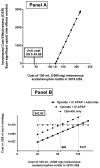Cost-effectiveness of intravenous acetaminophen and ketorolac in adolescents undergoing idiopathic scoliosis surgery
- PMID: 29377376
- PMCID: PMC6004284
- DOI: 10.1111/pan.13329
Cost-effectiveness of intravenous acetaminophen and ketorolac in adolescents undergoing idiopathic scoliosis surgery
Abstract
Background: Enhanced recovery after surgery protocols increasingly use multimodal analgesia after major surgeries with intravenous acetaminophen and ketorolac, despite no documented cost-effectiveness of these strategies.
Aims: The goal of this prospective cohort study was to model cost-effectiveness of adding acetaminophen or acetaminophen + ketorolac to opioids for postoperative outcomes in children having scoliosis surgery.
Methods: Of 106 postsurgical children, 36 received only opioids, 26 received intravenous acetaminophen, and 44 received acetaminophen + ketorolac as analgesia adjuncts. Costs were calculated in 2015 US $. Decision analytic model was constructed with Decision Maker® software. Base-case and sensitivity analyses were performed with effectiveness defined as avoidance of opioid adverse effects.
Results: The groups were comparable demographically. Compared with opioids-only strategy, subjects in the intravenous acetaminophen + ketorolac strategy consumed less opioids (P = .002; difference in mean morphine consumption on postoperative days 1 and 2 was -0.44 mg/kg (95% CI -0.72 to -0.16); tolerated meals earlier (P < .001; RR 0.250 (0.112-0.556)) and had less constipation (P < .001; RR 0.226 (0.094-0.546)). Base-case analysis showed that of the 3 strategies, use of opioids alone is both most costly and least effective, opioids + intravenous acetaminophen is intermediate in both cost and effectiveness; and opioids + intravenous acetaminophen and ketorolac is the least expensive and most effective strategy. The addition of intravenous acetaminophen with or without ketorolac to an opioid-only strategy saves $510-$947 per patient undergoing spine surgery and decreases opioid side effects.
Conclusion: Intravenous acetaminophen with or without ketorolac reduced opioid consumption, opioid-related adverse effects, length of stay, and thereby cost of care following idiopathic scoliosis in adolescents compared with opioids-alone postoperative analgesia strategy.
Keywords: cost-effectiveness; intravenous acetaminophen; ketorolac; multimodal analgesia; pain; spine fusion.
© 2018 John Wiley & Sons Ltd.
Conflict of interest statement
The authors report no conflict of interest.
Figures



References
-
- Russo CA, Merrill CT, Friedman B. Healthcare Cost and Utilization Project (HCUP) Statistical Briefs [Internet] Rockville, MD: Agency for Healthcare Research and Quality (US); 2007. Apr, [Accessed August 2017]. Procedures with the most rapidly increasing hospital costs, 2000–2004: Statistical Brief #28. 2006 FebAvailable from: https://www.ncbi.nlm.nih.gov/books/NBK63482/
-
- Sculpher M. Clinical trials provide essential evidence, but rarely offer a vehicle for cost-effectiveness analysis. Value Health. 2015;18:141–142. - PubMed
-
- Pizzi LT, Toner R, Foley K, et al. Relationship between potential opioid-related adverse effects and hospital length of stay in patients receiving opioids after orthopedic surgery. Pharmacotherapy. 2012;32:502–514. - PubMed
-
- Kamerlink JR, Quirno M, Auerbach JD, et al. Hospital cost analysis of adolescent idiopathic scoliosis correction surgery in 125 consecutive cases. J Bone Joint Surg Am. 2010;92:1097–1104. - PubMed
-
- Wainwright TW, Immins T, Middleton RG. Enhanced recovery after surgery (ERAS) and its applicability for major spine surgery. Best Pract Res Clin Anaesthesiol. 2016;30:91–102. - PubMed
MeSH terms
Substances
Grants and funding
LinkOut - more resources
Full Text Sources
Other Literature Sources
Medical

